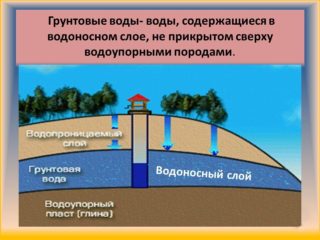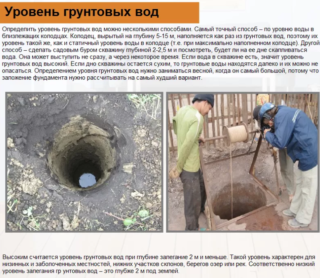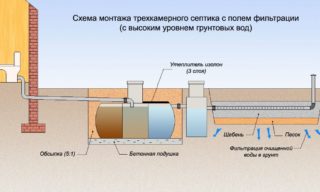The proximity of underground sources complicates the arrangement of the sewerage system in a private house or in the country and its maintenance. Problems can arise both during the installation process and during the further operation of the highways and the treatment plant. It is worth figuring out how to make an effective sewage system in a private house if groundwater runs close to the surface.
Danger of proximity to groundwater
With further use of the system, there is a risk of water seeping into the cleaning device. If the tank is not tight enough, for example made of concrete rings, it will fill up very quickly. This will require frequent calls to the flushers. If the tank overflows, the wastewater will start to flood the bathtub and toilet.
Overflowing a treatment plant is dangerous:
- the appearance of an unpleasant odor;
- the spread of infection;
- destruction of the walls of the device.
The soil in the area adjacent to the reservoir will eventually become swampy from excess moisture, which will lead to corrosion of pipes if they are made of metal.
Underground springs are rarely perfectly clean. They contain acidic or alkaline substances, which leads to corrosion of the walls of the tanks and their further deformation. Pebbles with sharp edges in the water make the situation worse.
Determination of the level of underground sources
- find out from the neighbors;
- analyze what flora grows on the site;
- drill a well.
The first method is the simplest. If someone in the neighborhood has already equipped the local sewage system with their own hands, they will tell you the level of occurrence of underground sources.
Moisture-loving sedge, cattail, reed, marsh wild rosemary, and fluffy birch speak about the high location of ground streams. If they grow on the territory, the aquifer is only half a meter. Canary grass, meadowsweet meadows indicate a meter depth of occurrence. Where spruces, heather, blackberries, mouse peas, white bent leaves, meadow fescue grow, the groundwater level is about one and a half meters.
These two methods provide a rough estimate of the location of subsurface sources. To clarify the situation, test wells are being drilled.
Stages of work:
- In two or three places on the site where the sewerage is supposed to be installed, a well is created with a two-meter drill.
- Cover the holes with polyethylene so that possible rain does not interfere with the study.
- A wooden stick is marked every 10 cm.
- The measuring tool is lowered into the wells one day after their creation and the moisture level is determined. If the "indicator" is 20 cm wet, then the subsoil streams are located 180 cm from the surface.
Test drilling is best done in spring or after heavy rainfall when soil moisture is at its maximum.
Features of sewerage installation
Constructions made of concrete rings will not work in this case. But if this is the only option, they should be well waterproofed, all seams should be filled with concrete mortar with hydrophobic additives.
It is better to use plastic tanks to create a summer cottage sewage system in an area with a high groundwater level. They are inexpensive and moisture resistant. Since such devices are lightweight, after a heavy downpour or in the spring, they can float up and break the entire communication structure. To prevent this from happening, they are fixed to the concrete base with the help of anchors.
It is even better to purchase a factory septic tank with multi-stage wastewater treatment. Such an installation is not cheap, but pays off with a minimum of time spent on its operation and increased reliability.
The following brands of ready-made cleaning devices are suitable for flooded areas:
- "Tank". Consists of several devices made of plastic with a thickness of 1.7 cm, which allows it to withstand heavy loads. Does not float to the surface when flooded.
- "Triton". Manufacturers offer several options for reliable septic tanks, but they require anchoring on a concrete base.
- "Leopard". The robust design of three chambers with two levels of bioremediation is suitable for areas with sources close to the surface.
- Ecopan. Recommended for installation in loams and soils prone to heaving. Holds loads well.
- "Tver". A comprehensive cleaning system suitable for wetlands. It brightens drains well, but requires an electricity source.
When choosing a ready-made septic tank for an area with high humidity, you need to check the tightness of the structure, its strength and ease of use.
Choice of treatment design and installation steps
If you decide not to hire professionals and not to purchase a ready-made sewage treatment plant, the device of a local sewage system in a private house with a high level of groundwater involves the creation of a sealed cesspool or a multi-chamber bioseptic.
Sealed cesspool
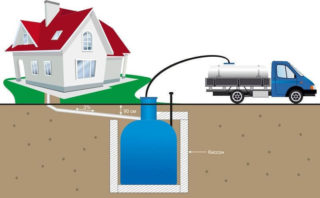
In areas where water flows are close to the surface, it is easiest to install a sealed plastic storage device with a hatch for pumping sewage with your own hands. You won't have to spend a lot of time and money on installation, but the design will require regular pumping.
It is desirable that the bottom of the structure is at a distance of one meter to the aquifer. If this is not possible, the purification device is constructed as follows:
- Dig two holes, one for the size of the container, the other about 0.5 m deep.
- A sealed container is installed in a large one and connected with a pipe segment to the second recess.
- A sewer line is connected to the main tank.
- An infiltration cassette is installed in the second pit, which will draw in and filter moisture. Or install a pump to pump water into the nearest ditch.
The disadvantage of the cassettes is that they freeze in winter. Therefore, the devices are insulated before installation.
Multichamber bioseptic
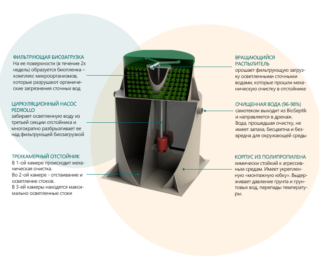
This option is more expensive but more effective. For places where underground sources are located shallow, a device with three chambers is suitable. It is also better to create them on the basis of sealed plastic containers. To prevent them from floating up during operation, you should anchor them to concrete foundations at the bottom.
After the installation of the tanks, an infiltration tunnel is created, located near the ground surface.
- A trench is dug 50 cm deep and 15 cm wide.
- A sand-gravel cushion is created at its bottom for drainage. Thickness - 30 cm.
- Infiltration cassettes are laid, connected to a cleaning device and covered with soil.
After burying, it is advisable to pour a mound of earth over the tunnel to insulate the cassettes in winter.
Correct installation of sewer lines and a sewage treatment device will allow you to use the amenities even for those whose houses and summer cottages are located in swampy, flooded areas.

